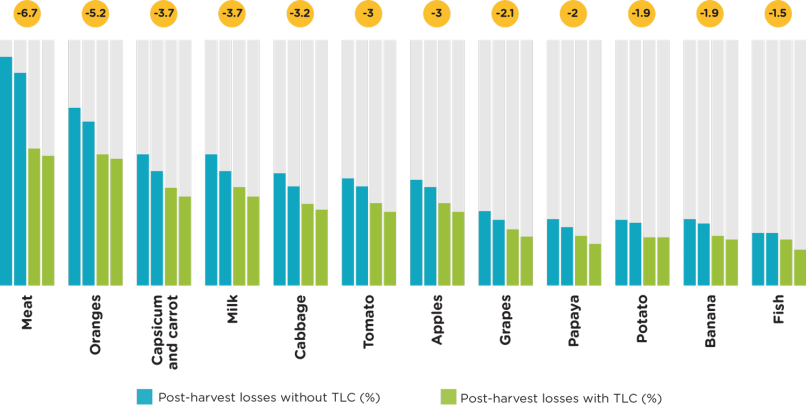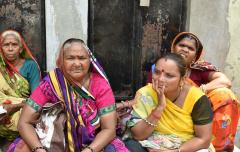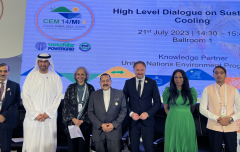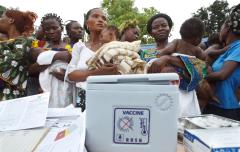Chilling Prospects 2022: Integration of inland waterways in the cold chain in West Bengal
|
Reflections on five years of the Kigali Amendment by the World Bank Group |
West Bengal produces a lot of fruits, vegetables and fish, and has well-connected networks of highways and railways. However, transport accounts for 2.6 million tonnes of greenhouse gas (GHG) emissions in the state. In addition, inefficiencies and a lack of transport connectivity adversely affect the state’s economy, increase congestion and contribute to post-harvest losses of temperature-sensitive goods. Waterways have the potential to support a multi-modal cold chain transportation network with reduced emissions, environmental impact, fuel usage and costs.
Potential of inland waterways
| Environmental impact | 7 times less than roadways |
| Carbon friendly mode of transport | For every tonne-km transported on water, the GHG emission is estimated to be 50% of that by road |
| Most fuel-efficient mode of transport | 105 tonne-km by with 1-litre fuel |
| Low maintenance cost | 20% that of road |
| Low capital cost | 5-10% to that of a 4-lane highway/railway |
|
Source: World Bank Group |
Improving the inland waterways infrastructure
To address this, the Government of India, the Government of West Bengal and the World Bank signed a USD 105 million project to improve inland waterway (IW) infrastructure and spatial planning in Kolkata in January 2021. To complement this lending project, the World Bank with funding from the UK’s Department for Environment, Food and Rural Affairs (DEFRA) contracted KPMG India and the International Institute of Refrigeration (IIR) to undertake a pilot study on IW integration in the West Bengal Cold Chain to reduce congestion, GHG emissions and hydrofluorocarbon (HFC) refrigerant usage.
The initial baseline assessment of the project reviewed the demand and emissions of temperature-sensitive goods such as fruits, vegetables and fish in West Bengal across the post-harvest, primary-transport, cold-storage and distribution segments of the cold chain. The study, conducted by KPMG India and IRR under the World Bank, found that in 2020, the total Temperature Controlled Logistics (TCL) demand was 6.28 million tonnes, accounting for 1.98 million MWh of energy consumption and over 620,000 tonnes of CO2 emissions annually.
A key driver of the demand arises from the production and transportation of temperature-sensitive goods. About 65-70 percent of freight in India is transported by road and the transportation of fruits and vegetables to and from Kolkata wholesale markets and mandis primarily takes place in non-refrigerated trucks. This results in food spoiling, reduced shelf life and post-harvest losses to the tune of 10-15 percent. The global footprint of food loss and waste excluding emissions from land-use change is 3.3 gigatonnes of GHG, corresponding to about 7 percent of total GHG emissions. There is a need for a new cold chain infrastructure for most products.
An efficient, well connected cold chain in West Bengal has the potential to significantly reduce post-harvest losses
The Government of India has shown a keen interest in IWs as a means of diversifying and improving the transport modal mix, which could also reduce post-harvest losses while reducing the negative environmental impact and cost of meeting the cold chain demand. IW transport has an environmental impact which is seven times less than roadways, and for every tonne-Km transported on water, the GHG emission is estimated to be 50 percent of that by road. Additionally, IW is a fuel-efficient mode of transport (105 tonne/km with one litre of fuel), has a lower capital cost (about 5–10 percent of that of a four-lane highway/ railway), and maintenance costs 20 percent lower than roads. In order to understand the feasibility of transporting temperature-sensitive goods on waterways, the study looked at the potential impact of diverting traffic to IW.
Integrating inland waterways with RoRo cargo services
In 2026, there is the potential to divert around 30,556 tonnes of traffic to IW while around 233,409 tonnes could potentially be diverted via roll-on roll-off (RoRo) cargo service. In 2035, around 210,419 tonnes could be diverted to IW and around 1,084,346 tonnes could be diverted to RoRo. With the integration of IW and RoRo services, there is the potential for GHG emissions savings of around 10 percent and 27 percent in 2026 and 2035, respectively. In addition, with the adoption of newer technologies, fisheries could save up to 77 percent of their energy consumption by 2030 and fruits and vegetables could save up to 77 percent. Cold storage for potatoes could save up to 75 percent by shifting to improved technologies. The fruit and vegetable value chain could save about 38 percent in post-harvest refrigeration but could save up to 77 percent in transportation. The dairy value chain could save 83 percent of its energy demand by the end of 2030.







